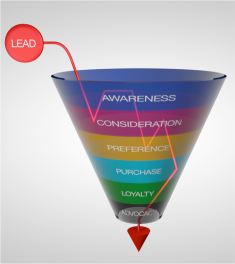Demand generation and marketing automation is nothing new. Yet, many B2B marketers can safely argue that established practice doesn’t imply proficiency, let alone a higher degree of marketing performance. In fact, according to Forrester half of B2B marketers surveyed don’t have well-defined processes in place to govern their marketing automation efforts. The result? A demand generation approach that behaves more like an automated drip system delivering generic emails and a high volume of barely qualified leads. To turn this around, I believe the path to performance and proficiency starts with a refresh around buyer fundamentals.
Top Five Buyer Fundamentals

#1: Buyers move around a lot
Most demand generation strategies major on adding leads to the top of the funnel, with less attention given to nurturing buyers midstream, or dare I say, mid-funnel. This assumes that your buyer travels a highly linear path from one buyer journey phase to the next. In reality buyers move around and oscillate a lot. Often they plateau along their journey as their priorities or budgets change. Marketers need to be mindful of this fluidity and develop strategies that acknowledge and support their movement and moments of pause along their journey.
#2: Buyers are different
According to Marketo, 31% of B2B marketers don’t have personas in place and out of those who do only 27% said their personas were aligned to their messaging (2015 Demand Gen Report Benchmark Study). A deep understanding of your buyer is essential for an effective demand generation strategy. It determines who needs to be engaged (identifying the real decision-makers and influencers), when they need to be engaged (at what stage of the purchase journey), how they can be reached (the most effective channel to reach them,) and what type of content they need (the right message and format).
#3: Buyers prefer messages that matter to them
Most companies in the UK think of marketing automation as the distribution of 3rd party content by email. This might deliver the quantity, but the whole purpose of demand generation and marketing automation is to take the effort out of early-stage selling, with high quality leads. This can most effectively be achieved through bespoke content, tailored to and addressing the specific concerns of each key stakeholder at the relevant point in their buyer journey. Depending on the buyer personas, this more often than not will include a combination of formats and channels, with online advertising, email newsletters, blog posts and articles influencing the early stages of the sales funnel, and testimonials, analysts’ reports and demos reserved for the latter stages.
#4: Buyers leave bread crumbs. Our job is to track and record them
According to Trip Kucera it takes up to 8 to 10 marketing touches to close a deal (2014 B2B Content2Conversion Conference), which means that last touch attribution may tell a misleading story. Using platforms like Marketo, will provide transparency on the value of each piece of content and the efficacy of the channel in which it is distributed.
#5: Not all buyers will buy. Score and segment your most valuable leads
Underpinning marketing automation is lead qualification or scoring. This tells us how close someone is to becoming a sales qualified lead. All the above investment in developing buyer profiles and content strategies will be to no avail if the scoring isn’t effective. Two fundamental pieces of this part of the puzzle are the initial data, which should be clean, and the scoring, which needs to be constantly monitored and refined. More specific details about this here.
If you aren’t following some or all of the above, 2015 could be your chance to turn things around. Get in touch if you need help!